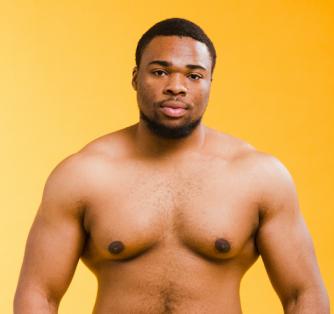Menu
Weight loss
Hormones
Sex
EXPLORE
MEET NU IMAGE MEDICAL
TREATMENTS
MEET NU IMAGE MEDICAL
TREATMENTS
MEET NU IMAGE MEDICAL
Gynecomastia (Breast Enlargement in Males) Treatment Options


Hormones have a profound effect on the body. They regulate functioning, control body processes, and determine physical characteristics. However, there are times when hormones can throw things out of whack and cause unexpected issues like gynecomastia.
According to experts, gynecomastia is a condition in which a man experiences an increase in breast tissue. Gynecomastia develops when estrogen and testosterone levels are imbalanced. As a rule, gynecomastia does not pose a problem to one’s health. However, this condition may lead to feelings of embarrassment. Gynecomastia may go away by itself, or it may become a permanent problem.
It is not uncommon for men and boys with this condition to experience pain in their breasts. The majority of men do not have symptoms, but this condition does have a number of symptoms. Men with this condition may experience swollen breast tissue, nipple sensitivity to clothing, and breast tenderness.
Boys are more likely to report breast pain. It is important to see a doctor if you experience symptoms, such as the following:
-
Pain
-
Tenderness
-
Nipple discharge in one or both breasts
But what causes gynecomastia? According to experts at the Mayo Clinic, gynecomastia develops when the amount of testosterone in a man’s body is lower than estrogen levels in his body. More than 50 percent of all male infants are born with larger breasts, because they inherit the side effects of their mother’s estrogen.
However, this condition can develop during puberty, when boys experience hormonal changes. For the vast majority of boys, this condition will go away between a span of six months to two years.
Men and boys who have this condition may find that their breasts grow unevenly,” experts say.
What are the treatment options for gynecomastia? Although gynecomastia may be caused by hormonal changes, the cause of the condition is largely unknown. Certain medications have gynecomastia as a side effect. Antidepressants, medications for prostate cancer, and medications for ulcers have the potential to produce symptoms of this condition.
But what are your treatment options for this condition? According to PubMed, gynecomastia is the most prevalent breast condition in males. To diagnose this condition, a doctor will first rule out breast cancer as the cause of one’s breast enlargement. This is rare, although it does happen. Your doctor will also do a full physical examination. The doctor will need to determine whether both breasts are affected.
The doctor will also consider how long you have been dealing with the condition. Gynecomastia does not necessarily require surgery. The appropriate treatment for this condition will depend on the cause of gynecomastia. The clothing you wear can affect your condition.
You can hide your gynecomastia by wearing shirts that have patterns and pinstripes. It may also help to wear contrasting colors between your shirts and pants. Thicker clothing may also hide the condition.
Making dietary and lifestyle changes is another good way to treat this condition. Individuals who are overweight tend to carry more weight in the chest area, so it may help to shed some pounds. Increasing testosterone levels may also effectively treat this condition.
Certain lifestyle changes have a profound effect on the condition. You can treat this condition by doing the following:
-
Reducing your alcohol consumption
-
Eating a healthy diet
-
Doing strength training at least twice each week
A number of foods contain phytoestrogens. These chemicals imitate estrogen that occurs naturally in a man’s body. The role of these chemicals is not fully understood, and more research is needed to validate the benefits of this chemical. However, many believe that foods containing phytoestrogens elevate testosterone, so testosterone levels are higher than estrogen levels in the body. Legumes, licorice root, and soy are great sources of phytoestrogen.
Exercising is another great way to treat gynecomastia. Aerobic exercises in particular are the most beneficial in treating this condition. Experts recommend swimming, jogging, skating, and brisk walking. Additionally, simple activities, like dancing and skipping, can be used to treat this condition.
Building muscle is another great way to treat gynecomastia. According to experts, doing reps and sets can help. You can add weights into your exercise routine to increase resistance and make the exercise more intense.
A number of medications may serve as good treatments for this condition. Androgens, such as Danazol and dihydrotestosterone, may be used as treatment. Aromatase inhibitors, such as anastrozole and letrozole, are viable treatment options. Your doctor may also prescribe a number of other medications to treat this condition.
Experts assert that off-label medications are often effective in treating gynecomastia. Your doctor may prescribe drugs that are used to treat other conditions to treat your gynecomastia. Your doctor may prescribe medication that is used to treat cancer. Tamoxifen or Soltamox can be used as treatment. Aromatase inhibitors, such as Arimidex, are also known to be effective.
While lifestyle changes can be effective in treating gynecomastia, surgery is often the only option to resolve and get rid of this condition. Many men consider breast reduction surgery to get rid of the excess fat in the breast area. Also called reduction mammaplasty, this procedure reduces male breasts.
However, there may be cases where gynecomastia is so severe that it requires a breast lift. A breast lift is typically needed when a man has developed a drooping breast envelope. But how do you know if you’re a good candidate for this surgery?
Gynecomastia is often the result of hormonal imbalances, and these imbalances can be caused by certain illegal drugs and some prescriptions. Reducing mammaplasty is the procedure of choice for many men. A doctor uses a thin metal cannula to perform this procedure. Small scars can remain from where the cannula was inserted into the skin. This procedure is best suited to men whose breasts consist of a small to medium amount of breast fat. This procedure may be a bit more complex for men with firmer breasts. The doctor may also perform an excision on breast tissue.
Your doctor will discuss this procedure with you and will tell you the degree of scarring you will experience after the procedure is complete. Scars may not appear until after the incisions have healed. However, you can try to minimize the appearance of these scars by applying ointments or creams to the affected areas. Massages and injections may also help to minimize the appearance of scars.
What do breast reduction scars feel and look like? According to health experts, breast reduction scars typically are lighter in color than the rest of your skin. Scars can appear red, pink, gray, or brown. In some cases, scars may feel tender or itch after you have surgery. There are several different types of breast scars that result from different incisions. Let’s look at two popular incision techniques.
-
Vertical or lollipop procedure. For this procedure, your doctor makes two incisions. One incision will be around the areola, while the other incision is a vertical incision from the bottom of the areola to the “crease at the bottom of your breast,” according to the Cleveland Clinic.
-
Inverted or anchor procedure. For this procedure, your doctor will make three incisions. One incision will be made around the edge of the areola. Another incision will be made from the lower part of your areola to the crease of your breast. The third incision will run along the crease of your breast.
You can try to keep scarring to a minimum/ However, scars cannot be prevented. There is no way to know what type of scars you will have after surgery. The size and shape of your scars will ultimately depend on the technique your doctor used. Based on your situation, your doctor can suggest a technique that is best for you.
The appearance of your scars will change after six weeks. Your scars may have bandages on them, so you may not realize you have scars until the bandage is removed. After a period of six months, your scars will be slightly raised above the rest of your skin. After one year has passed, the appearance of scars will fade, and will blend in with the rest of your skin.
There are many benefits to this surgery. One of the greatest benefits of reducing mammaplasty is its ability to ease the pain and discomfort produced by the weight of excessively large breasts. In addition, this surgery can relieve neck and back pain and reduce chafing. At the same time, it improves the shape and size of your breasts.
The overall appearance of one’s breasts are improved with this surgery, and many find that they no longer have back pain. Some men may find that their clothes fit more comfortably. Shopping for clothes often becomes easier for this reason. Having smaller breasts can also make it easier and more comfortable to be physically active.
An additional benefit of this procedure is that most men enjoy a happier life, because they no longer carry around weight in their breasts. As a result, pain is minimized. Men who get this surgery will need to wear a compression bra for a minimum of three months after the surgery.
14 Sources
Nu Image Medical has strict sourcing guidelines to ensure our content is accurate and current. We rely on peer-reviewed studies, academic research institutions, and medical associations. We strive to use primary sources and refrain from using tertiary references.
https://www.mayoclinic.org/diseases-conditions/gynecomastia/symptoms-causes/syc-20351793
https://www.hopkinsmedicine.org/health/conditions-and-diseases/gynecomastia
https://www.ncbi.nlm.nih.gov/pmc/articles/PMC3987263/
https://www.news-medical.net/health/Diagnosis-of-Gynecomastia.aspx
https://www.healthline.com/health/gynecomastia-treatment-without-surgery#exercise
https://www.ncbi.nlm.nih.gov/books/NBK279105/
https://www.mayoclinic.org/diseases-conditions/gynecomastia/diagnosis-treatment/drc-20351799
https://med.stanford.edu/cosmeticsurgery/aestheticservices/Breast/gynecomastia.html
https://medlineplus.gov/ency/article/001942.htm
https://my.clevelandclinic.org/health/treatments/24782-breast-reduction-scars
https://my.clevelandclinic.org/health/treatments/24782-breast-reduction-scars
https://my.clevelandclinic.org/health/diseases/16227-enlarged-male-breast-tissue-gynecomastia
https://www.healthline.com/health/breast-reduction-scars
This article is for informational purposes only and does not constitute medical advice. The information contained herein is not a substitute for and should never be relied upon for professional medical advice. Always talk to your physician about the risks and benefits of any treatment. Nu Image Medical may not offer the medications or services mentioned in this article.
